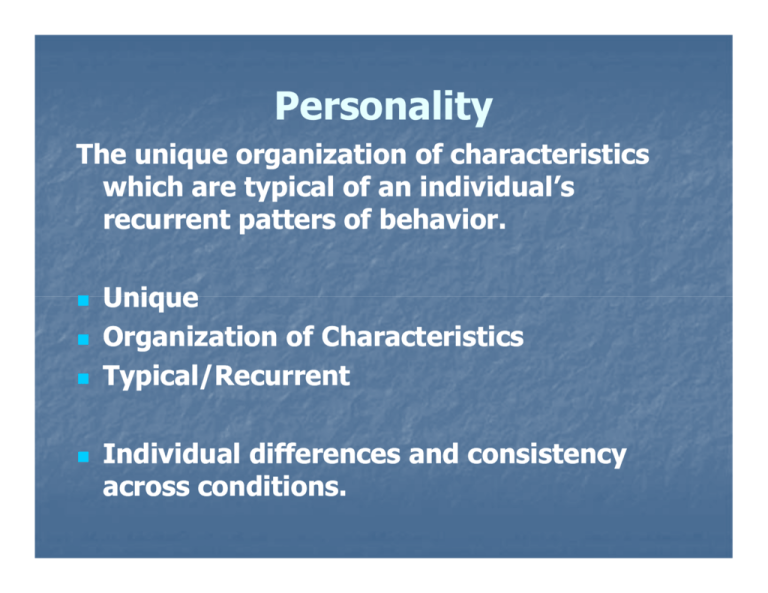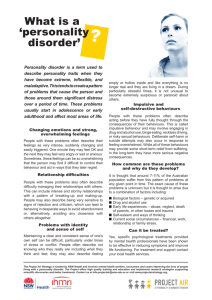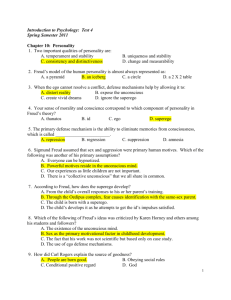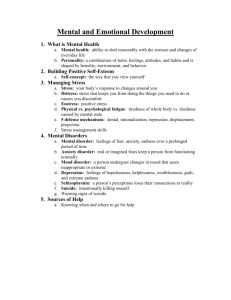Personality - Weber State University
advertisement

Personality The unique organization of characteristics which are typical of an individual’s recurrent patters of behavior. Unique Organization of Characteristics Typical/Recurrent Individual differences and consistency across conditions. Behavior as complex interaction of Who you are is affected by the environment and vise-versa. Person What you do affects what you think and believe and vise-versa Behavior Environment What you do affects the environment and vise-versa Idiographic Theorists – only concerned with the uniqueness of personality Nomothetic Theorists - personality is unique but it is not profitable to talk about personality this way. They focus in on NORMS. Sigmund Freud Mind is divided into three parts Conscious Preconscious Unconscious Most Important Repressed memories Free Association, Dreams, Freudian slips Personality is divided into three parts Id: Operates according to the pleasure principle Primitive and unconscious part of personality Pleasure Principle/Primary Process Instincts Eros – life, pleasure Thanatos – death, aggression Avoid pain and seek pleasure Primitive and unconscious part of personality Sexual and aggressive instincts Ego: Operates according to the reality principle Originally tries to restrain the impulses of the Id Then it mediates between id and superego Reality Principle/Secondary Process Defines the “I” in each of us Defense Mechanisms – your book! Protect the Ego from itself Unconscious/Anxiety/Denial and distortion DENIAL Refusing to acknowledge a painful or threatening reality – denying it from consciousness Example Danny, who is told that he has terminal lung cancer, believes instead that he simply has bronchitis REPRESSION Excluding uncomfortable thoughts from consciousness thought, feelings, and ideas which cause us anxiety. Example Lisa, who was once caught shoplifting when she was in high school, has no recollection of the embarrassing event PROJECTION Attributing to others thoughts, feelings, ideas which cause us anxiety Example Martin is unfairly passed over for a promotion; he denies that he is angry, but is certain that his boss is angry with him IDENTIFICATION Taking on the characteristics of someone else to avoid feeling anxious Example Malcolm, uncertain of his own attractiveness, takes on the dress and mannerisms of a popular older student REGRESSION Reverting to childlike behavior and defenses as a means of overcoming anxiety Example Angry because his plan to reorganize his division has been rejected, Bob throws a tantrum INTELLECTUALIZATION/ RATIONALIZATION Thinking abstractly about stressful problems as a way of detaching oneself from them hence reducing anxiety Example After learning that she has not been asked to a classmate’s party, Tona coolly discusses the ways in which social cliques form and how they serve to regulate and control school life REACTION FORMATION Expression of exaggerated ideas and emotions that are the opposite of one’s true beliefs, feelings, and/or attitudes Example Michael outwardly professes how denigrating pornography is toward women, while he actually finds it very arousing DISPLACEMENT Shifting repressed emotions from an original object to a substitute object Example Angry at his professor’s unreasonable request that he rewrite his term paper, but afraid to confront his instructor, Abraham comes home and yells at housemates for telling him what to do SUBLIMATION Redirecting or substituting repressed motives and feelings into more socially acceptable channels Example Jasmine who is consumed by sexual thoughts becomes an accomplished OB/GYN Superego: Moral ideals and conscience. “Moral arm of personality.” What is right and what is wrong Conflict with the Id Just as “bad” as the Id Now Ego mediates Example on how the Ego mediates between the Id and the Superego Urge to drink right nownow-get drunk! (ID) Moral--should never drinkMoral drink-drinking is bad. (Superego) Can drink if I get someone else to drive. (EGO) Ego can be Pro or Anti something. Rational, mediating dimension of personality Conscious Ego Superego Moralistic, judgmental, perfectionist dimension of personality Irrational, illogical, impulsive dimension of personality Preconscious Unconscious Information in your immediate awareness Information which can easily be made conscious Id Thoughts, feelings, urges, and other information that is difficult to bring to conscious awareness Psycho-sexual stage Age Description Oral Birth - 1 year Pleasure is derived from oral activities such as sucking, biting and chewing. Fixation: Overly acquisitive Anal 1-3 years Pleasure from issues involving urination and defecation. Toilet training becomes a major conflict between parents and children and resolution has a lasting effect on the child's personality. Development of ego and defense mechanisms. Fixation: Overly retentive or disorganized mechanisms Phallic 3-6 years Pleasure comes from symbolic genital stimulation. Children develop incestuous desire for the opposite sex parent: Oedipus and Electra complex develops. Superego develops. Fixation: No internalization of Superego. Latency 6-11 years Sexual conflicts and desires are repressed due to trauma and guilt surrounding the Phallic stage. The ego and superego develop during this stage as children make gains in problem solving and internalizing societal values. Genital 12 onward Sexual urges become dominate in the individuals life. Adolescence is characterized by learning how to express these urges in socially acceptable ways. Carl G. Jung Personal unconscious – Freud’s unconscious and preconscious Collective unconscious Archetypes/dominants/primordial images Shadow – animal possibilities - Id Anima – Feminine possibilities Animus – Masculine possibilities Persona – Public masks we wear Type Theories William Sheldon Somatotype/Constitution/Body build Endomorph - Viscerotonia - 7-1-1 Mesomorph - Somatotonia - 1-7-1 Ectomorph - Cerebrotonia - 1-1-7 Combinations of the three Trait Theories/Describe but never explain Raymond Cattell Source – Cardinal Surface - Central Gordon Allport Cardinal - overriding Central – select a roommate unseen Secondary - preference McCrae and Costa’s Big Five Personality Traits Openness Conscientiousness Extraversion Agreeableness Neuroticism Humanism refers to the recognition of the value of the human being. Humanistic Psychology emphasize human potential It is a theory of healthy personalities and conditions under which less than healthy personalities can become healthy unlike other theories which use abnormal personalities. Subjective experience, self, selfself-image, fulfillment of potentials Abraham Maslow People are designed to develop a healthy personality. To define such a personality, he read case studies of his heroes: Abraham Lincoln, Thomas Jefferson, Eleanor Roosevelt Individuals grow from having Basic (or Deficiency) needs met to having Being (or Growth) needs met Psychological need – self self--acualizaion Maslow identified a selfself-actualized person: Self Self--aware/Self aware/Self--accepting Open and spontaneous Loving and caring Uninfluenced by others’ others’ opinions Fully enjoy friendships Has peak experiences Unashamed of who/what one is Examples of SelfSelf-Actualized people Martin Luther King, Jr. (civil rights activist) Eleanor Roosevelt (humanitarian, diplomat) Mother Teresa (humanitarian, spiritual leader) Gordon B. Hinckley and The Pope (spiritual leaders) Abraham Lincoln (politician, humanitarian) Carl Rogers Saw the tenacity of the human spirit and believed that a person’s basic tendencies are to actualize, maintain, and enhance life. Self Self--image of who you are and what you value. Conditional Positive Regard Conditions of Worth Unconditional Positive Regard Phenomenal Field – total subjective experience of reality. Assessment of Personality Interviews Personality Inventories - Objective MMPI MMPI--2 and California Personality Inv. Most widely used! Projective Tests Rorschach Inkblot Test Thematic Apperception Test - Murray IQ tests? Abnormal Psychology Any behavior or emotional state that causes an individual great suffering or worry, is self--defeating or selfself self-destructive, or is maladaptive and disrupts the person’s relationships or the larger community. Interferes with normal functioning. 400 Million people worldwide suffer psychological disorders (W.H.O.) 20% of American adults had an active disorder while 32% reported having experienced a psychological disorder at some time in their life. (NIMH) Females-- internalized and passive Females disorders (depression, anxiety) Males--externalized and active mental Males disorders (antisocial, alcohol abuse, impulse control problems) Mental Disorders account for 15.4 percent of the years of life lost due to death or disability. Descriptive Models Subjective Statistical Normative Cultural Explanatory Models Medical Faulty Learning/Behavioral Psychological Diathesis - Stress DSM-IV Current Standard for Defining DSMDisorders Axis I: Clinical Syndromes Axis II: Personality Disorders Axis III: General Medical Conditions Axis IV: Psychosocial and Environmental Conditions Axis V: Global Assessment of Functioning Scale Each diagnosis must include certain signs and symptoms. Use of DSMDSM-IV results in 83% agreement between therapists. DSM--IV diagnosis is necessary for DSM reimbursement by almost all insurances. Arguments against using the DSMDSM-IV include the negative impact of labels Anxiety Disorders Anxiety is the basis Most of us have had these Women tend to have them more Symptoms by themselves does not mean you have the disorder Generalized Anxiety Disorder: Includes chronic excessive worry about a number of events and activities (not identified) Must occur more days than not for at least 6 months Must be accompanied by at least 3 of following Restlessness/feelings of being keyed up/on edge A sense of being easily fatigued Difficulty concentrating or thinking Irritability Muscle tension Sleep disturbance Panic Disorder: An anxiety disorder in which a person experiences recurring panic attacks, feelings of impending doom or death, accompanied by physiological symptoms such as rapid breathing and dizziness. The person must have experienced recurrent unexpected panic attacks and must have been consistently concerned about having another attack or worried about the consequences of having another attack for at least one month. To be considered a full blown panic attack the episode must involve the abrupt onset of at least 4 of the following symptoms (not exhaustive): Shortness of breath Heart palpitations Sweating Dizziness Depersonalization Derealization Fear of dying, going crazy, losing control Phobia: An exaggerated, unrealistic fear of a specific situation, activity, or object. A morbid, irrational fear. Posttraumatic Stress Disorder (PTSD): An anxiety disorder in which a person who has experienced a traumatic or lifelifethreatening event has symptoms such as psychic numbing, reliving the trauma, and increased physiological arousal. Obsessive – Compulsive Disorder An anxiety disorder in which a person feels trapped in repetitive, persistent thoughts (obsessions) and repetitive, ritualized behaviors (compulsions) designed to reduce anxiety. The person must recognize that the obsession is a product of their own mind rather than from external sources The involuntary behavior must cause marked distress, consume excessive time, or interfere with occupational or social functioning Dissociative Disorders: Conditions in which consciousness or identity is split or altered. An escape from oneself Dissociative Amnesic Disorder Dissociative Fugue Disorder Dissociative Personality (Identity) Disorder A controversial disorder marked by the appearance within on person of two or more distinct personalities, each with its own name and traits; commonly known as “Multiple Personality Disorder.” This disorder is almost nonexistent outside of the U.S. Considered by Britain as a “Wacky American Fad” Considered by skeptics to be created by therapists in a particular social context. Psychosomatic Disorders Chronic stress may lower resistance and facilitate a predisposed physical condition Not caused by a physical disorder but instead seems linked to stress. Somatoform Disorders Exhibits symptoms suggesting physical disease or injury but for which there is no such disease or injury. Hypochondriasis Somatization Disorder Conversion Disorder Eating Disorders Anorexia Nervosa Bulimia Nervosa Obesity Mood/Affective Disorders Major Depressive Disorder is considered the common cold of mental health. Women are twice as vulnerable to major depression than men. Most major depressive episodes last less than 6 months. With each new generation, the rate of depression is increasing and the disorder is striking earlier. Major Depression: A mood disorder involving disturbances in emotion (excessive sadness) behavior (loss of interest in one’s usual activities) cognition (thoughts of hopelessness) and body function (fatigue and loss of appetite). Reduced interest in almost all activities Significant weight gain or loss, without dieting Sleep disturbance (insomnia or hypersomnia) Change in motor activity (too much or too little) Fatigue or loss of energy Feelings of worthlessness or guilt Reduced ability to think or concentrate Recurrent thoughts of death and/or suicide Bipolar Disorder Disorder in which the person alternates between the hopelessness and lethargy of depression and the overexcited state of mania. Manic states are characterized by a hyperactive, wildly optimistic state. Equal numbers of men and women present with this disorder. Mood Personality Disorders Coded on Axis II of the DSMDSM-IV Defined as: 1) LongLong-standing 2) pervasive 3) inflexible patterns of behavior and inner experience that deviate from the expectations of a persons culture and that impair social and occupational functioning. A personality disorder is defined by the extremes of several traits and by the rather inflexible and maladaptive way these traits are expressed. The personality each of us develops over the years reflects a persistent means of dealing with life’s challenges, a certain style of relating to other people (overly dependent, shy, aggressive, appearance) Antisocial Personality Disorder (APD): A disorder characterized by antisocial behavior such as lying, stealing, manipulating others, and sometimes violence; and a lack of guilt, shame and empathy. Sometimes called psychopathy or sociopathy. 2% insanity successful Insanity is a legal term Death penalty Schizophrenia/Psychosis Severe form of pathology What most of us think when we think of someone crazy Suffers a major deterioration in the ability to control thoughts and actions. They have lost contact with reality May have to be hospitalized Can be a danger to selves and others Positive symptoms Hallucinations and/or Delusions Disorganized thoughts and behaviors Loose or illogical thoughts Agitation Negative symptoms Flat or blunted affect Concrete thoughts Anhedonia (inability to experience pleasure) Poor motivation, spontaneity, and initiative Symptoms Withdrawal Unable to cope--own world Perceptual Symptoms Hallucinations-False perceptions Auditory-Most common Visual-Not common (drugs) Tactile Cognitive Symptoms Delusions-False beliefs Grandeur Believe something that not Believe have some great power Persecution Control Verbal Symptoms Neologisms Word Salad--confusion and incoherence Echolalia Clang Association 1%-2% of the population historically What does this mean? Lower socioeconomic groups NOT retarded Equal in males and females Mental Hospitals 50% to 75% are schizophrenic Disorganized (Hebephrenic) Type Disorganized speechspeech-Incoherent and illogical Disorganized/inappropriate behavior Most disturbed of all schizophrenias Withdraw and total collapse of reality testing Laughing inappropriately, silliness, Childlike/Childish disregard Severe disruption in ability to perform daily activities Many years of hospitalization Delusions/hallucinations if present are fragmented Catatonic Type Waxy flexibility or stupor phase. Excessive motor activity (that is purposeless and not influenced by external stimulistimuli-Excitement. Extreme negativism or mutism. Peculiarities of voluntary movement as evidenced by posturing, stereotyped movements, prominent mannerisms, or prominent grimacing. Echolalia or echopraxia Prognosis is usually good Why? Paranoid Type Preoccupation with one or more delusions or frequent auditory hallucinations relating to delusions. Grandeur, persecution Fairly intelligible speech and logical if basic premise is accepted Most common. Strongly resists treatment/ hospitalization – I’m NOT sick!! Prognosis? Genetic predispositions Structural brain abnormalities Neurotransmitter abnormalities – Extra dopamine receptors. Therapy Medical Drugs – last 50 years number in mental hospitals has declined Schizophrenia, anxiety ECT Surgery Psychoanalysis (Freud) Free Association Insight into unconscious motives and feelings Dream Analysis Transference Catharsis Behavioristic (Wolpe) 49% of faculty in accredited clinical psychology programs now align themselves with a cognitive or cognitive--behavioral therapy orientation cognitive Systematic Desensitization – phobias Progressive relaxation Aversion Therapy Implosive/Flooding/Exposure Token Economies – give chips Young and Retarded Cognitive Behavior Therapy or Rational Emotive Therapy (Ellis) A=Antecedent Condition or Event = Divorce B=Beliefs or Behaviors = “I’m a bad person.” C=Consequence = Depression If we get the person to challenge and change the irrational beliefs the consequences have got to change. Humanism (Rogers, Maslow) Client Client--Centered Therapy/NonTherapy/Non-Directive Places responsibility for the course of treatment on the client Potentials/Self Potentials/Self--Actualization Conditional/Unconditional Positive Regard Conditions of Worth What form of therapy is the most effective? Combination of therapeutic interventions with medications tend to be the best. History Anamism (4000 BC) Trephination – release evil spirits from the skull Middle ages (500 BC to 1600 AD) Possession of the soul by the devil Hippocrates Biogenic theorists Imbalance of the four bodily humors Institutions Enlightenment (1600(1600-1900) More humane care Pinel and Dix Today Biological Prevention






